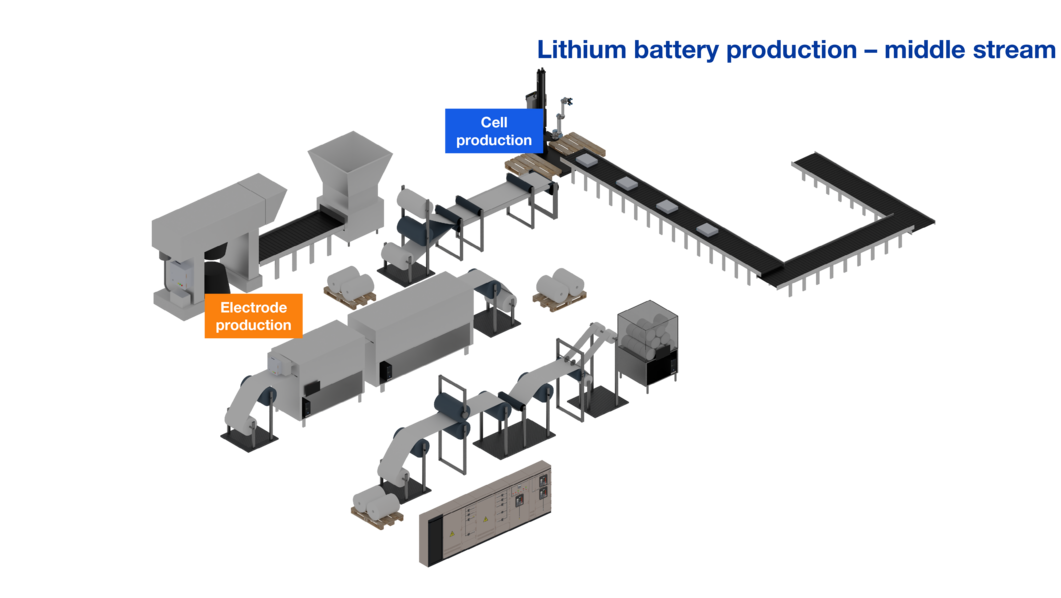Midstream - Battery production
Electrodes, separators, electrolytes, anodes, and cathodes are essential battery components. The magic that happens from energy storage within the battery depends on the quality of battery material and the energy density inside the battery. The distinctive difference between battery manufacturers as in the case of electric cars is the travel range, and/or life of the battery between charges.
Lithium is the lightest metal with the lowest density of all solid elements, and by nature in concentrate Lithium is stable for prolonged periods only at dry air humidity but will transform slowly to form lithium nitride.
In humid conditions, lithium hydroxide, the state of battery grade lithium reacts to the air to form a surface layer that interacts with the base. Like all alkali metals, lithium reacts to skin moisture to cause severe burns. This poses a significant challenge for a pump to transfer lithium slurries with a continuous deposit to the metal pump and system components.
In battery manufacturing, lithium, the component mostly critical for the production of a lithium ion battery, carries the positively charged electrons in electrolyte between the cathode and anode that is responsible for charging and discharging of the battery.
In manufacturing, the lithium slurry in suspension with lithium carbonite has high viscosity and is highly abrasive. The choice of available pump technologies becomes even more important when considering the nature of the pump material and the behaviour of lithium slurry in the manufacturing of the anode and cathode electrodes.
As mentioned before, the battery chemicals are both abrasive and corrosive, but adding to the complexity the slurry is also extremely shear sensitive. Consequently, the limitation of pump technologies is not only limited to resistant to abrasive wear, corrosive wear, and shear sensitive but also to meet the requirement of being non-conductive. Conductive metallic parts include copper, zinc, or nickel and as a result, the entire battery manufacturing facility will require pumps, components such as valves, seals and measuring equipment to be non-conductive.
In the manufacturing of the cathode precursor materials are:
- Cobalt and Nickel
In preparation:
- Salt dissolution and ammonia is transferred and dosed.
In reaction:
- Aqueous alkali (reaction to metals) and complexant is mixed to combine precursor grains (pH greater than 10) hydroxide ions.
And in post-production
- Once the crystals reach a set size the slurry is washed, filtered, and dried ready for cathode installation and service.
In anode graphitization:
- The process involves the exposure of raw materials to extreme high heat for prolonged periods whereafter the graphite is purified with hydrofluoric (HP), hydrochloric (HCL) sulfuric (H2SO4) acids.
In separator and electrode coating:
- A membrane placed between the anode and cathode to prevent the electrodes to come in contact but allows free movement of ion between them for energy transfer.
- Electrode coating is a mixture of polymer binders and solvents that this then coated with the slurry (anode and cathode) then importantly dried.

So where do our pumps fit in?
Verderflex Peristaltic pumps, in their very nature, are suitable for shear sensitive products, but in line with a suitable designed system based on peristaltic principles, laminar flow and the control of pulsation (with or without a dampener) protect the liquid to achieve as low as 1% shear. The Verderflex shoe design create enough velocity to firstly maintain solid suspension and secondly create enough movement to transfer highly viscus liquids without reaching deposition velocity of slurry particles at low transfer velocity. The fact is, within a Verderflex peristaltic pump, the only liquid contact point is the internal part of the hose. The optional flange components remove the risk of metal contact and contamination enabling the pump to remain non-conductive, that is extremely important to improve the energy density and quality of battery cells. Consequently, Verderflex pumps enable the customer to maintain the same battery footprint whilst achieving a higher energy density for prolonged battery life.
Verderair diaphragm pumps, including the PURE and AODD (air operated double diaphragm) pumps with non-conductive materials are perfectly suited for the requirements of a battery manufacturing facility. In an ATEX environment the brand excels to enable secure and safe liquid transfer and accurate dosing where PTFE pumps are best suited to high temperature and highly corrosive acids.
Depending on the level of accuracy both Verderflex peristaltic pump options and the Verderair diaphragm pump range is suitable for dosing applications.Within the battery manufacturing process, the Verder portfolio offer pumps suitable for:
• Low shear slurry transfer
• Industrial water treatment for re-use
• Lime dosing to correct water pH from the acid process
• Chemical dosing and dispensing
• Binder material transfer and dosing
• Electrode transfer and dosing
• The filter-press
